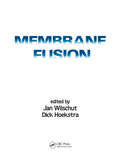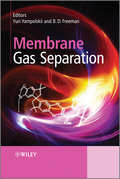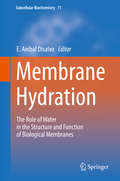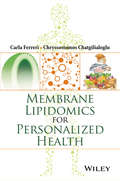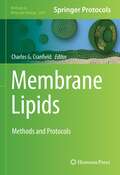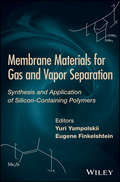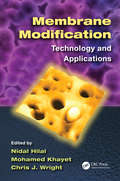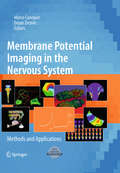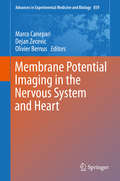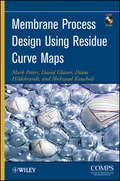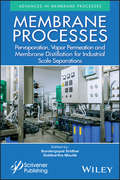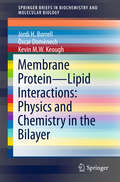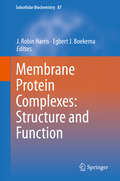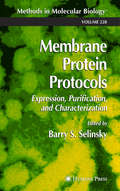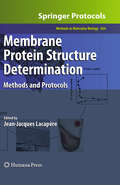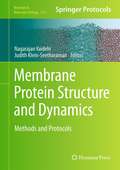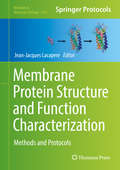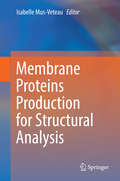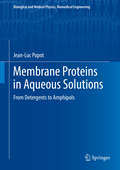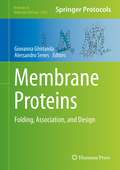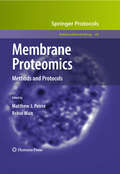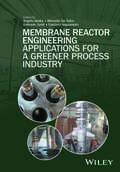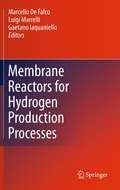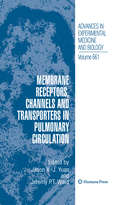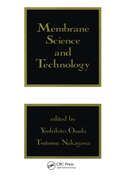- Table View
- List View
Membrane Fusion
by Jan WilschutThis balanced volume provides a broad and coherent overview of recent progress in membrane fusion research—highlighting an interdisciplinary treatment of the subject from the fields of biophysics, biochemistry, cell biology, virology, and biotechnology—in a single volume., Featuring easy-access sections on the general properties of membranes and applications of membrane fusion techniques, this valuable sourcebook outlines membrane structure, lipid polymorphism, and intermembrane forces ... covers membrane fusion in model systems ... presents the fusogenic properties of enveloped viruses ... discusses the fusion and flow of intracellular membranes and cell-cell fusion occurring during fertilization and myogenesis ... offers applications of membrane fusion techniques in cell-biological research and biotechnology ... and more. Supplying a comprehensive view of this exciting topic, Membrane Fusion is a working resource for molecular, cell, and membrane biologists; biophysicists; biochemists; virologists; biotechnologists; microbiologists; immunologists; physiologists; and graduate and medical school students in biophysics, biochemistry, physiology, virology, cell biology, and biotechnology.
Membrane Gas Separation
by Benny Freeman Yuri YampolskiiGas separation membranes offer a number of benefits over other separation technologies, and they play an increasingly important role in reducing the environmental impacts and costs of many industrial processes.This book describes recent and emerging results in membrane gas separation, including highlights of nanoscience and technology, novel polymeric and inorganic membrane materials, new membrane approaches to solve environmental problems e.g. greenhouse gases, aspects of membrane engineering, and recent achievements in industrial gas separation. It includes:Hyperbranched polyimides, amorphous glassy polymers and perfluorinated copolymersNanocomposite (mixed matrix) membranesPolymeric magnetic membranesSequestration of CO2 to reduce global warmingIndustrial applications of gas separationDeveloped from sessions of the most recent International Congress on Membranes and Membrane Processes, Membrane Gas Separation gives a snapshot of the current situation, and presents both fundamental results and applied achievements.
Membrane Hydration
by E. Anibal DisalvoThis book is about the importance of water in determining the structure, stability and responsive behavior of biological membranes. Water confers to lipid membranes unique features in terms of surface and mechanical properties. The analysis of the hydration forces, plasticiser effects, controlled hydration, formation of microdomains of confined water suggests that water is an active constituent in a water-lipid system. The chapters describe water organization at the lipid membrane-water interphase, the water penetration, the long range water structure in the presence of lipid membranes by means of X-ray and neutron scattering, general polarization, fluorescent probes, ATR-FTIR and near infrared spectroscopies, piezo electric methods, computer simulation and surface thermodynamics. Permeation, percolation, osmotic stress, polarization, protrusion, sorption, hydrophobicity, density fluctuations are treated in detail in self-assembled bilayers. Studies in lipid monolayers show the correlation of surface pressure with water activity and its role in peptide and enzyme interactions. The book concludes with a discussion on anhydrobiosis and the effect of water replacement in microdomains and its consequence for cell function. New definitions of lipid/water interphases consider water not only as a structural-making solvent but as a mediator in signalling metabolic activity, modulating protein insertion and enzymatic activity, triggering oscillatory reactions and functioning of membrane bound receptors. Since these effects occur at the molecular level, membrane hydration appears fundamental to understand the behavior of nano systems and confined environments mimicking biological systems. These insights in structural, thermodynamical and mechanical water properties give a base for new paradigms in membrane structure and function for those interested in biophysics, physical chemistry, biology, bio and nano medicine, biochemistry, biotechnology and nano sciences searching for biotechnological inputs in human health, food industry, plant growing and energy conversion.
Membrane Lipidomics for Personalized Health
by Carla Ferreri Chryssostomos ChatgilialogluLipidomics is an important aspect of personalized medicine in relation to nutrition and metabolism. This approach has become important due to the substantial presence of nutraceuticals in the market, since it gives personalized criteria on how to choose the right nutraceutical strategy for both prevention and for quality of life. This multi-disciplinary textbook uses a simple and practical approach to provide a comprehensive overview of lipidomics and their connection with health and nutrition. The text is divided into two parts: - Part 1 outlines the basics of lipidomics and focuses on the biochemical and nutritional aspects with descriptions of the analytical methods employed for the examination of cell membrane fatty acid composition. - Part 2 familiarizes the reader with the use of membrane lipidomic diagnostics in practical health care, using health conditions as examples to introduce the concept of lipidomic profiles in different physiological and pathological situations including prevention. Through the various properties of membrane lipidomics, readers will be able to combine the molecular status of the cell membrane with the evaluation of the subject for personalized nutritional and nutraceutical strategies. Membrane Lipidomics for Personalized Health will be beneficial to biologists, biochemists and medical researchers, as well as health care professionals, pharmacists, and nutritionists seeking in-depth information on the topic.
Membrane Lipids: Methods and Protocols (Methods in Molecular Biology #2402)
by Charles G. CranfieldThis detailed book explores examples of current in vitro and in silico techniques that are at the forefront of lipid membrane research today. Beginning with methods and strategies associated with the creation and use of lipid membrane models in various research settings, the volume continues with electrical impedance spectroscopy strategies and methods to identify how ions and proteins interact with model lipid bilayers, guidance on lipid bilayer in silico molecular dynamics modeling, novel techniques to explore lipid bilayer characteristics using neutron scattering, IR spectroscopy, and atomic force microscopy (AFM), as well as unique fluorescence techniques. Written in the highly successful Methods in Molecular Biology series style, chapters include introductions to their respective topics, lists of the necessary materials, step-by-step, readily reproducible laboratory protocols, and tips on troubleshooting and avoiding known pitfalls. Authoritative and cutting-edge, Membrane Lipids: Methods and Protocols serves as an ideal guide for researchers seeking to further investigate the often complicated world of lipid membrane biophysics.
Membrane Materials for Gas and Separation: Synthesis and Application fo Silicon-containing Polymers
by Yuri Yampolskii E. FinkelshteinSi containing polymers have been instrumental in the development of membrane gas separation practices since the early 1970s. Their function is to provide a selective barrier for different molecular species, where selection takes place either on the basis of size or on the basis of physical interactions or both. Combines membrane science, organosilicon chemistry, polymer science, materials science, and physical chemistry Only book to consider polymerization chemistry and synthesis of Si-containing polymers (both glassy and rubbery), and their role as membrane materials Membrane operations present environmental benefits such as reduced waste, and recovered/recycled valuable raw materials that are currently lost to fuel or to flares
Membrane Modification: Technology and Applications
by Nidal Hilal Chris J. Wright Mohamed KhayetMembrane Modification: Technology and Applications is written for engineers, scientists, graduate students, and researchers in the field of membrane science and technology, materials science, applied physics, chemistry, and environmental science. The book presents the complete range of membrane modification techniques used to increase efficiency of
Membrane Potential Imaging in the Nervous System
by Dejan Zecevic Marco CanepariThe book is structured in five sections, each containing several chapters written by experts and major contributors to particular topics. The volume starts with a historical perspective and fundamental principles of membrane potential imaging and continues to cover the measurement of membrane potential signals from dendrites and axons of individual neurons, measurements of the activity of many neurons with single cell resolution, monitoring of population signals from the nervous system, and concludes with the overview of new approaches to voltage-imaging. The book is targeted at all scientists interested in this mature but also rapidly expanding imaging approach.
Membrane Potential Imaging in the Nervous System and Heart
by Dejan Zecevic Marco Canepari Olivier BernusThis volume discusses membrane potential imaging in the nervous system and in the heart and modern optical recording technology. Additionally, it covers organic and genetically-encoded voltage-sensitive dyes; membrane potential imaging from individual neurons, brain slices, and brains in vivo; optical imaging of cardiac tissue and arrhythmias; bio-photonics modelling. This is an expanded and fully-updated second edition, reflecting all the recent advances in this field. Twenty chapters, all authored by leading names in the field, are cohesively structured into four sections. The opening section focuses on the history and principles of membrane potential imaging and lends context to the following sections, which examine applications in single neurons, networks, large neuronal populations and the heart. Topics discussed include population membrane potential signals in development of the vertebrate nervous system, use of membrane potential imaging from dendrites and axons, and depth-resolved optical imaging of cardiac activation and repolarization. The final section discusses the potential - and limitations - for new developments in the field, including new technology such as non-linear optics, advanced microscope designs and genetically encoded voltage sensors. Membrane Potential Imaging in the Nervous System and Heart is ideal for neurologists, electro physiologists, cardiologists and those who are interested in the applications and the future of membrane potential imaging.
Membrane Process Design Using Residue Curve Maps
by David Glasser Diane Hildebrandt Mark Peters Shehzaad KauchaliDesign and Synthesis of Membrane Separation Processes provides a novel method of design and synthesis for membrane separation. While the main focus of the book is given to gas separation and pervaporation membranes, the theory has been developed in such a way that it is general and valid for any type of membrane. The method, which uses a graphical technique, allows one to calculate and visualize the change in composition of the retentate (non-permeate) phase. This graphical approach is based on Membrane Residue Curve Maps. One of the strengths of this approach is that it is exactly analogous to the method of Residue Curve Maps that has proved so successful in distillation system synthesis and design.
Membrane Processes: Pervaporation, Vapor Permeation and Membrane Distillation for Industrial Scale Separations
by S. Sridhar Siddhartha MoulikSeparation processes are challenging steps in any process industry for isolation of products and recycling of reactants. Membrane technology has shown immense potential in separation of liquid and gaseous mixtures, effluent treatment, drinking water purification and solvent recovery. It has found endless popularity and wide acceptance for its small footprint, higher selectivity, scalability, energy saving capability and inherent ease of integration into other unit operations. There are many situations where the target component cannot be separated by distillation, liquid extraction, and evaporation. The different membrane processes such as pervaporation, vapor permeation and membrane distillation could be used for solving such industrial bottlenecks. This book covers the entire array of fundamental aspects, membrane synthesis and applications in the chemical process industries (CPI). It also includes various applications of pervaporation, vapor permeation and membrane distillation in industrially and socially relevant problems including separation of azeotropic mixtures, close-boiling compounds, organic–organic mixtures, effluent treatment along with brackish and seawater desalination, and many others. These processes can also be applied for extraction of small quantities of value-added compounds such as flavors and fragrances and selective removal of hazardous impurities, viz., volatile organic compounds (VOCs) such as vinyl chloride, benzene, ethyl benzene and toluene from industrial effluents.Including case studies, this is a must-have for any process or chemical engineer working in the industry today. Also valuable as a learning tool, students and professors in chemical engineering, chemistry, and process engineering will benefit greatly from the groundbreaking new processes and technologies described in the volume.
Membrane Protein - Lipid Interactions: Physics and Chemistry in the Bilayer
by Jordi H. Borrell Òscar Domènech Kevin M. W. KeoughThis book has been conceives as a brief introduction to biomembranes physical chemistry for undergraduate students of sciences, and it is particularly dedicated to the lipid-protein membrane interactions. A general introduction is presented in Chapters 1 and 2. The following Chapters, 3 and 4, describe the most accepted theories on lipid-membrane protein interactions as well as the new experimental approaches, in particular, these arose from nano sciences as atomic for microscopy and single molecule force spectroscopy. The book emphasizes the relevance of physical parameters as the lateral surface pressure and the lipid curvature as actors for understanding the physicochemical properties of the biomembranes.
Membrane Protein Complexes: Structure and Function (Subcellular Biochemistry #87)
by J. Robin Harris Egbert J. BoekemaThis edited book contains a compilation of 14 advanced academic chapters dealing with the structure and function of membrane protein complexes. This rapidly advancing important field of study closely parallels those on soluble protein complexes, and viral protein and nucleoprotein complexes. Diverse topics are included in this book, ranging from membrane–bound enzymes to ion channels, proton pumps and photosystems. Data from X-ray crystallography, cryo-electron microscopy and other biophysical and biochemical techniques are presented throughout the book. There is extensive use of colour figures of protein structures. Throughout the book structure and function are closely correlated. The two editors, Egbert Boekema and J. Robin Harris, have worked on aspects of membrane and soluble proteins throughout their scientific careers and also have much publishing experience. The Subcellular Biochemistry series has expanded considerably in recent years, including several related volumes. The theme of protein complexes will be continued within several future volumes, thereby creating encyclopaedic coverage. The chapter topics within this book are particularly relevant to those involved in the biological and biomedical sciences. It is aimed at the advanced undergraduates, postgraduates and established researchers within this broad field. It is hoped that the book will be of interest and use to those involved with the study of cellular membranes and their associated proteins.
Membrane Protein Protocols
by Barry S. SelinskyA collection of key techniques for the study of receptors and transport proteins. The book provides examples of how different membrane proteins can be overexpressed in both prokaryotic and eukaryotic expression systems, how natural and overexpressed proteins can be solubilized from their host membranes, and how the solubilized protein can be purified in active form. Each protocols contains step-by-step instructions to ensure success, troubleshooting advice, lists of reagents, and tips on avoiding pitfalls.
Membrane Protein Structure Determination
by Jean-Jacques LacapèreMembrane proteins, representing nearly 40% of all proteins, are key components of cells involved in many cellular processes, yet only a small number of their structures have been determined. Membrane Protein Structure Determination: Methods and Protocols presents many detailed techniques for membrane protein structure determination used today by bringing together contributions from top experts in the field. Divided into five convenient sections, the book covers various strategies to purify membrane proteins, approaches to get three dimensional crystals and solve the structure by x-ray diffraction, possibilities to gain structural information for a membrane protein using electron microscopy observations, recent advances in nuclear magnetic resonance (NMR), and molecular modelling strategies that can be used either to get membrane protein structures or to move from atomic structure to a dynamic understanding of a molecular functioning mechanism. Written in the highly successful Methods in Molecular BiologyTM series format, chapters include introductions to their respective topics, lists of the necessary materials and reagents, step-by-step, readily reproducible laboratory protocols, and tips on troubleshooting and avoiding known pitfalls. Comprehensive and easy to use, Membrane Protein Structure Determination: Methods and Protocols serves as an ideal reference for scientists seeking to further our knowledge of these vital and versatile proteins as well as our overall understanding of the complicated world of cell biology.
Membrane Protein Structure and Dynamics
by Nagarajan Vaidehi Judith Klein-SeetharamanMembrane proteins play key roles in numerous cellular processes, in particular mediating cell-to-cell communication and signaling events that lead to a multitude of biological effects. Membrane proteins have also been implicated in many critical diseases such as atherosclerosis, hypertension, diabetes and cancer. In Membrane Protein Structure Predictions Methods: Methods and Protocols, expert researcher in the field detail the advances in both experimental and computational approaches of the structure, dynamics and interactions of membrane proteins dividing the volume into two sections. The first section details the procedures used for measurements of structure and dynamics of membrane proteins. While the second section contains a survey of the computational methods that have played a critical role in membrane protein structure prediction as well as in providing atomic level insight into the mechanism of the dynamics of membrane receptors. Written in the highly successful Methods in Molecular BiologyTM series format, the chapters include the kind of detailed description and implementation advice that is crucial for getting optimal results in the laboratory. Thorough and intuitive, Membrane Protein Structure Predicitons: Methods and Protocols seeks to aid scientists in the further study of membrane protein structure and function.
Membrane Protein Structure and Function Characterization
by Jean-Jacques LacapereIn this present volume, different approaches are detailed to produce membrane proteins, purify them, study their function, determine their structure, and model them in membrane. Since every membrane protein behaves mostly in a unique way /fashion, knowledge of guidelines and tricks may help to increase chances to express, purify and characterize a peculiar membrane protein. Production of correctly folded protein remains a challenge. Moreover, getting a functional and stable protein requires to optimize membrane mimicking environments that can be detergent or artificial membranes. In some cases, the finding of the correct ligand which will stabilize the desired conformation is needed. In other cases, stabilization can be obtained using specific antibodies. This volume also presents different techniques to analyze the functional status of membrane proteins. Written in the highly successful Methods in Molecular Biology series format, chapters in Membrane Protein Structure and Function Characterization: Methods and Protocols provide different techniques to analyze the functional and structural status of membrane proteins. Chapters include introductions to their respective topics, lists of the necessary materials and reagents, step-by-step, readily reproducible laboratory protocols, and tips on troubleshooting and avoiding known pitfalls. Authoritative and practical, Membrane Protein Structure and Function Characterization: Methods and Protocols aims to ensure successful results in the further study of this vital field.
Membrane Proteins Production for Structural Analysis
by Isabelle Mus-VeteauThis book updates the latest development in production, stabilization and structural analysis techniques of membrane proteins. This field has made significant advances since the elucidation of the first 3-D structure of a recombinant G Protein Coupled Receptor (GPCR), rhodopsin, with the structure of several more GPCRs having been solved in the past five years. In fact, the 2012 Nobel Prize in Chemistry was awarded for groundbreaking discoveries on the inner workings of GPCRs. This book is essential reading for all researchers, biochemists and crystallographers working with membrane proteins, who are interested by the structural characterization of their favorite protein and who wish to follow the expression, migration, modifications and recycling of a membrane protein.
Membrane Proteins in Aqueous Solutions: From Detergents to Amphipols (Biological and Medical Physics, Biomedical Engineering)
by Jean-Luc PopotThis book is the first to be entirely devoted to the challenging art of handling membrane proteins out of their natural environment, a key process in biological and pharmaceutical research, but one plagued with difficulties and pitfalls. Written by one of the foremost experts in the field, Membrane Proteins in Aqueous Solutions is accessible to any member of a membrane biology laboratory. After presenting the structure, functions, dynamics, synthesis, natural environment and lipid interactions of membrane proteins, the author discusses the principles of extracting them with detergents, the mechanisms of detergent-induced destabilization, countermeasures, and recent progress in developing detergents with weaker denaturing properties. Non-conventional alternatives to detergents, including bicelles, nanodiscs, amphipathic peptides, fluorinated surfactants and amphipols, are described, and their relative advantages and drawbacks are compared. The synthesis and solution properties of the various types of amphipols are presented, as well as the formation and properties of membrane protein/amphipol complexes and the transfer of amphipol-trapped proteins to detergents, nanodiscs, lipidic mesophases, or living cells. The final chapters of the book deal with applications: membrane protein in vitro folding and cell-free expression, solution studies, NMR, crystallography, electron microscopy, mass spectrometry, amphipol-mediated immobilization of membrane proteins, and biomedical applications. Important features of the book include introductory sections describing foundations as well as the state-of-the-art for each of the biophysical techniques discussed, and topical tables which organize a widely dispersed literature. Boxes and annexes throughout the book explain technical aspects, and twelve detailed experimental protocols, ranging from in vitro folding of membrane proteins to single-particle electron cryomicroscopy, have been contributed by and commented on by experienced users. Membrane Proteins in Aqueous Solutions offers a concise, accessible introduction to membrane protein biochemistry and biophysics, as well as comprehensive coverage of the properties and uses of conventional and non-conventional surfactants. It will be useful both in basic and applied research laboratories and as a teaching aid for students, instructors, researchers, and professionals within the field.
Membrane Proteins: Folding, Association, and Design
by Giovanna Ghirlanda Alessandro SenesFocusing on model systems for the study of structure, folding, and association in the membrane, Membrane Proteins: Folding, Association, and Design presents an overview of methods that can be applied to these intricate systems. The volume is divided into four detailed sections, covering association of transmembrane helices, interactions with the lipid bilayer, NMR methods, as well as a variety of engineering approaches. Written for the highly successful Methods in Molecular Biology series, chapters include introductions to their respective topics, lists of the necessary materials and reagents, step-by-step, readily reproducible laboratory protocols, and tips on troubleshooting and avoiding known pitfalls. Authoritative and practical, Membrane Proteins: Folding, Association, and Design serves as an ideal guide for researchers reaching for the tantalizing possibility of designing novel membrane proteins with tailored functionality.
Membrane Proteomics
by Matthew J. Peirce Robin WaitWith the great cellular and therapeutic importance of plasma membrane proteins, unbiased technologies such as proteomics become even more vital as they have the power to define patterns of membrane protein expression characteristic of distinct states of cellular development, differentiation or disease, and thereby identify novel markers of, or targets for intervention in, disease. In Membrane Proteomics: Methods and Protocols, leading experts in the field compile a laboratory bench resource which provides a comprehensive toolkit of proven methods. The volume delves into various modifications to standard two-dimensional gel electrophoresis protocols as well as liquid chromatographic methods, protocols for the enrichment of diverse classes of plasma membrane proteins, in silico approaches, and cutting-edge techniques for quantitative membrane protein profiling. Written in the highly successful Methods in Molecular BiologyTM series format, chapters include brief introductions to their respective topics, lists of the necessary materials and reagents, step-by-step, readily reproducible laboratory protocols, and notes on troubleshooting and avoiding known pitfalls. Comprehensive and easy-to-use, Membrane Proteomics: Methods and Protocols is an ideal guide for investigators wishing to apply state of the art membrane proteomic methodologies in their own research programs.
Membrane Reactor Engineering: Applications for a greener process industry
by Gaetano Iaquaniello Marcello De Falco Angelo Basile Gabriele CentiUniquely focussed on the engineering aspects of membrane reactors Provides tools for analysis with specific regard to sustainability Applications include water treatment, wastewater recycling, desalination, biorefineries, agro-food production Membrane reactors can bring energy saving, reduced environmental impact and lower operating costs
Membrane Reactors for Hydrogen Production Processes
by Gaetano Iaquaniello Marcello De Falco Luigi MarrelliMembrane Reactors for Hydrogen Production Processes deals with technological and economic aspects of hydrogen selective membranes application in hydrogen production chemical processes. Membrane Reactors for Hydrogen Production Processes starts with an overview of membrane integration in the chemical reaction environment, formulating the thermodynamics and kinetics of membrane reactors and assessing the performance of different process architectures. Then, the state of the art of hydrogen selective membranes, membrane manufacturing processes and the mathematical modeling of membrane reactors are discussed. A review of the most useful applications from an industrial point of view is given. These applications include: natural gas steam reforming,autothermal reforming,water gas shift reaction,decomposition of hydrogen sulphide, andalkanes dehydrogenation.The final part is dedicated to the description of a pilot plant where the novel configuration was implemented at a semi-industrial scale. Plant engineers, researchers and postgraduate students will find Membrane Reactors for Hydrogen Production Processes a comprehensive guide to the state of the art of membrane reactor technology.
Membrane Receptors, Channels and Transporters in Pulmonary Circulation
by Jason X. Yuan Jeremy P. WardMembrane Receptors, Channels and Transporters in Pulmonary Circulation is a proceeding of the 2008 Grover Conference (Lost Valley Ranch and Conference Center, Sedalia, Colorado; September 3-7, 2008), which provided a forum for experts in the fields of those receptors, channels and transporters that have been identified as playing key roles in the physiology and pathophysiology of the pulmonary circulation. The book rigorously addresses: i) recent advances in our knowledge of receptors, channels and transporters and their role in regulation of pulmonary vascular function; ii) how modulation of expression and function of receptors, channels and transporters and their interrelationships contribute to the pathogenesis of pulmonary vascular disease; and iii) the therapeutic opportunities that may be revealed by enhancing our understanding of this area. The overall goal was to explore the mechanisms by which specific receptors, channels and transporters contribute to pulmonary vascular function in both health and disease, and how this knowledge may lead to novel interventions in lung dysplasia, pulmonary edema, lung injury, and pulmonary and systemic hypertension to reduce and prevent death from lung disease. Membrane Receptors, Channels and Transporters in Pulmonary Circulation is divided into six parts. Part 1 (Ion Channels in the Pulmonary Vasculature: Basics and New Findings) is designated for basic knowledge and recent findings in the research field of ion channels in pulmonary circulation. There are five chapters in Part I discussing the function, expression, distribution and regulation of various ion channels present in pulmonary vascular smooth muscle cells and how these channels are integrated to regulate intracellular Ca2+ and cell functions. Part II (TRP Channels in the Pulmonary Vasculature: Basics and New Findings) is composed of five chapters that are exclusively designed to discuss the role of a recently identified family of cation channels, transient receptor potential (TRP) channels, in the regulation of pulmonary vascular tone and arterial structure. Part III (Pathogenic Role of Ion Channels in Pulmonary Vascular Disease) includes four chapters that discuss how abnormal function and expression of various ion channels contribute to changes in cell functions and the development of pulmonary hypertension. Part IV (Receptors and Signaling Cascades in Pulmonary Arterial Hypertension) consists of five chapters devoted to the role of bone morphogenetic protein receptors, Notch receptors, serotonin receptors, Rho kinase and vascular endothelial growth factor receptors in the development of pulmonary arterial hypertension. Part V (Receptors and Transporters: Role in Cell Function and Hypoxic Pulmonary Vasoconstriction) includes four chapters designed to illustrate the potential mechanisms involved in oxygen sensing and hypoxia-induced pulmonary vasoconstriction and hypertension. Part VI (Targeting Ion Channels and Membrane Receptors in Developing Novel Therapeutic Approaches for Pulmonary Vascular Disease) consists five chapters which discuss the translational research involving on membrane receptors, channels and transporters, including their potential as novel drug targets. We hope that Membrane Receptors, Channels and Transporters in Pulmonary Circulation will allow readers to foster new concepts and new collaborations and cooperations among investigators so as to further understand the role of receptors, channels and transporters in lung pathophysiology. The ultimate goal is to identify new mechanisms of disease, as well as new therapeutic targets for pulmonary vascular diseases. An additional outcome should be enhanced understanding of the role of these entities in systemic vascular pathophysiology, since the conference will include researchers and clinicians with interests in both pulmonary and systemic circulations.
Membrane Science and Technology
by Yoshihito Osada Tsutomu NakagawaThis volume covers the theory and applications of transport phenomena in synthetic membranes - describing modern membrane preparation methods, structures, characteristics and properties.;Examining different types of membranes and how they are used, Membrane Science and Technology: presents the physical and chemical fundamentals of membrane science;
